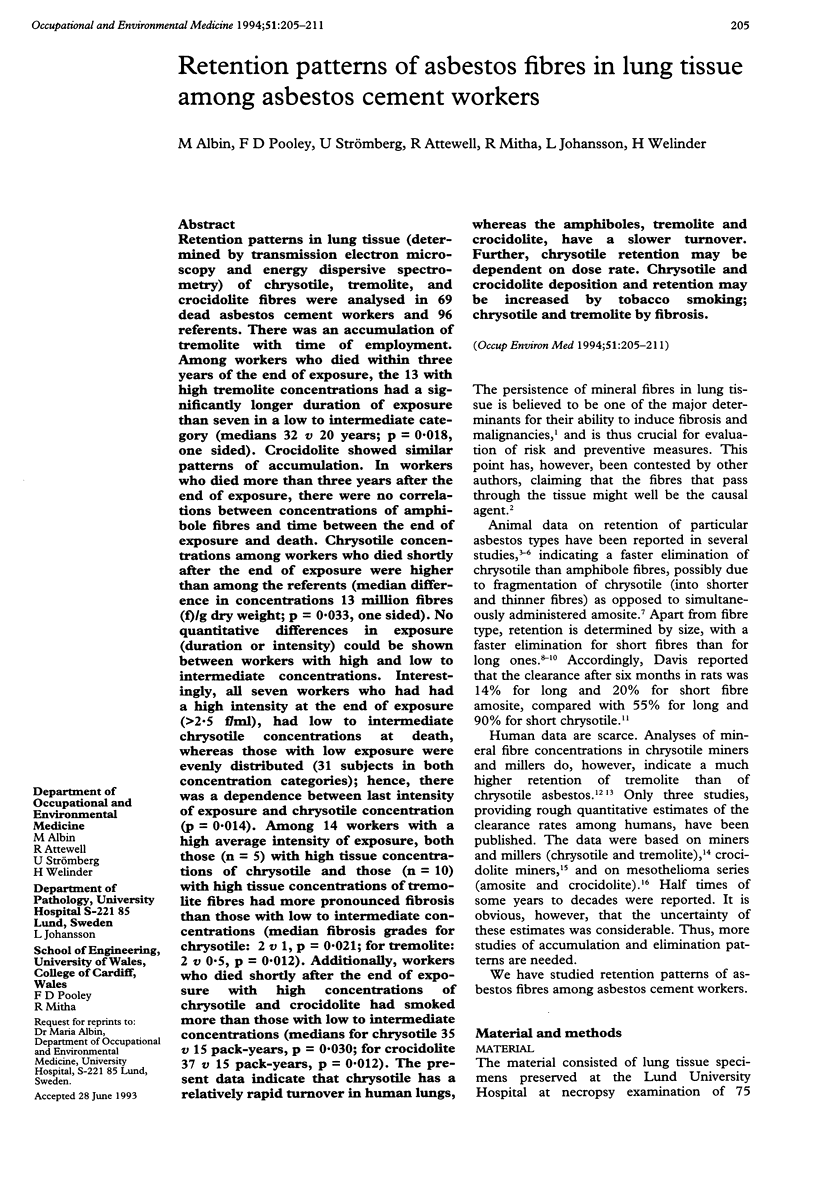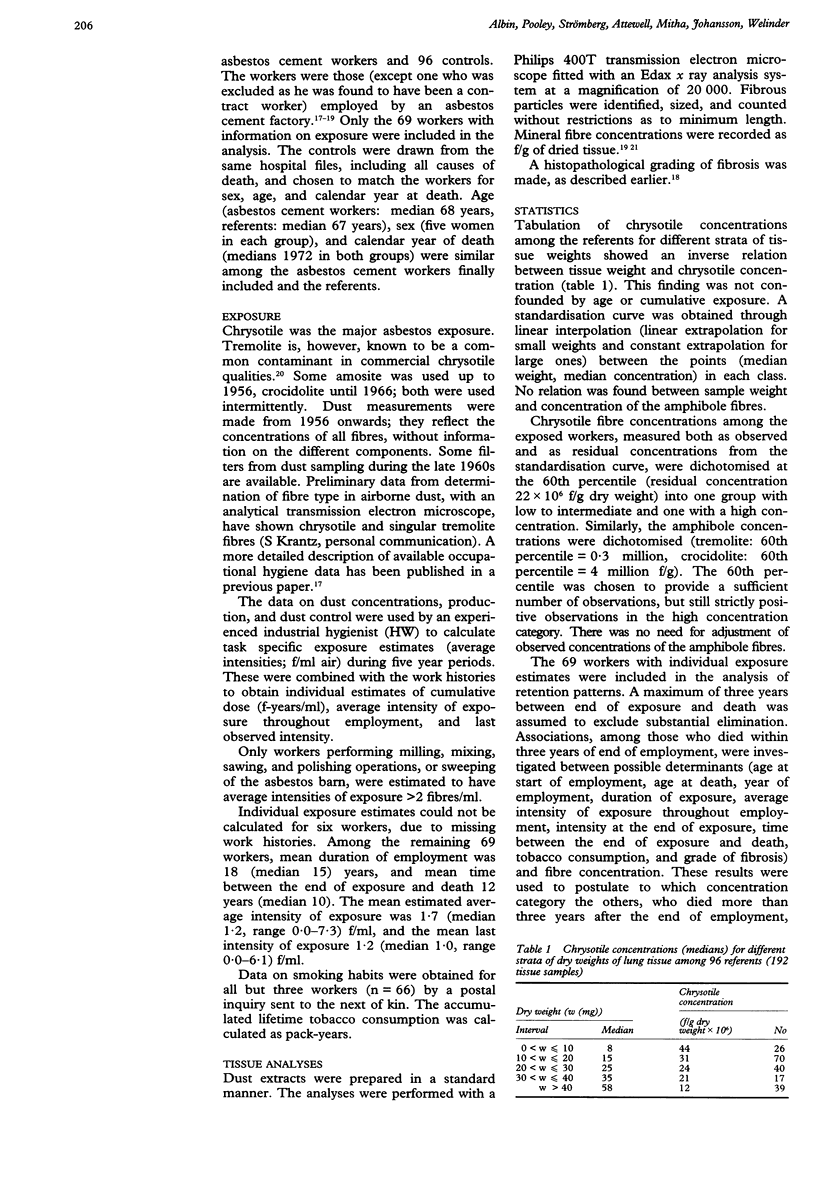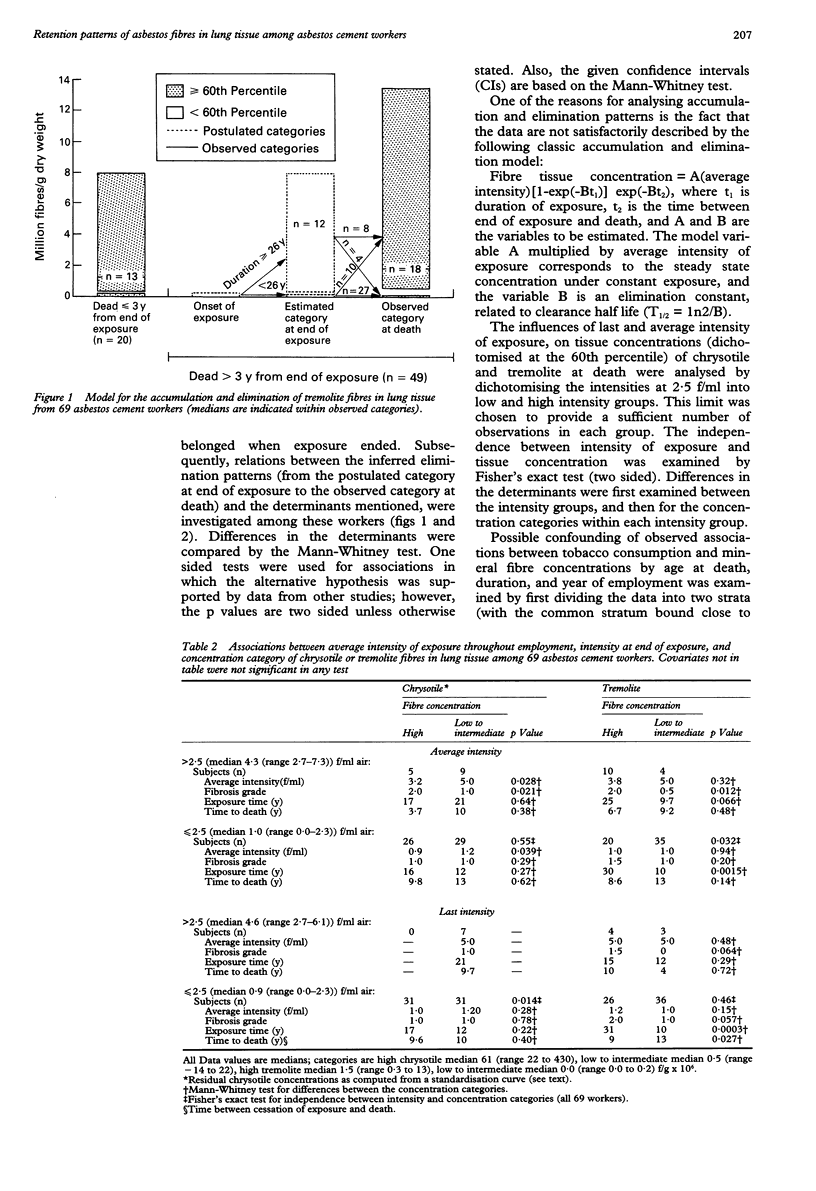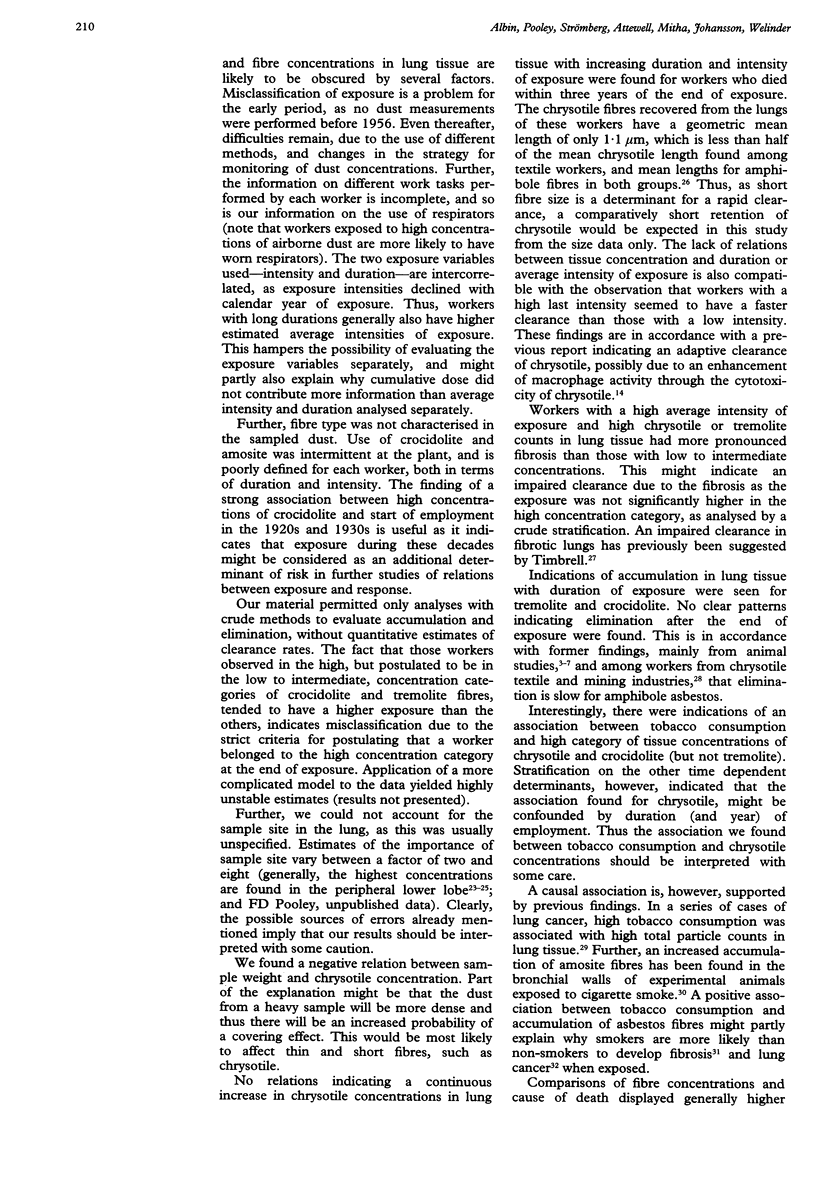Abstract
Retention patterns in lung tissue (determined by transmission electron microscopy and energy dispersive spectrometry) of chrysotile, tremolite, and crocidolite fibres were analysed in 69 dead asbestos cement workers and 96 referents. There was an accumulation of tremolite with time of employment. Among workers who died within three years of the end of exposure, the 13 with high tremolite concentrations had a significantly longer duration of exposure than seven in a low to intermediate category (medians 32 v 20 years; p = 0.018, one sided). Crocidolite showed similar patterns of accumulation. In workers who died more than three years after the end of exposure, there were no correlations between concentrations of amphibole fibres and time between the end of exposure and death. Chrysotile concentrations among workers who died shortly after the end of exposure were higher than among the referents (median difference in concentrations 13 million fibres (f)/g dry weight; p = 0.033, one sided). No quantitative differences in exposure (duration or intensity) could be shown between workers with high and low to intermediate concentrations. Interestingly, all seven workers who had had a high intensity at the end of exposure (> 2.5 f/ml), had low to intermediate chrysotile concentrations at death, whereas those with low exposure were evenly distributed (31 subjects in both concentration categories); hence, there was a dependence between last intensity of exposure and chrysotile concentration (p = 0.014). Among 14 workers with a high average intensity of exposure, both those (n = 5) with high tissue concentrations of chrysotile and those (n = 10) with high tissue concentrations of tremolite fibres had more pronounced fibrosis than those with low to intermediate concentrations (median fibrosis grades for chrysotile: 2 v 1, p = 0.021; for tremolite: 2 v 0.5, p = 0.012). Additionally, workers who died shortly after the end of exposure with high concentrations of chrysotile and crocidolite had smoked more than those with low intermediate concentrations (medians for chrysotile 35 v 15 pack-years, p = 0.030; for crocidolite 37 v 15 pack-years, p = 0.012). The present data indicate that chrysotile has a relatively rapid turnover in human lungs, whereas the amphiboles, tremolite and crocidolite, have a slower turnover. Further, chrysotile retention may be dependent on dose rate. Chrysotile and crocidolite deposition and retention may be increased by tobacco smoking; chrysotile and tremolite by fibrosis.
Full text
PDF






Selected References
These references are in PubMed. This may not be the complete list of references from this article.
- Addison J., Davies L. S. Analysis of amphibole asbestos in chrysotile and other minerals. Ann Occup Hyg. 1990 Apr;34(2):159–175. doi: 10.1093/annhyg/34.2.159. [DOI] [PubMed] [Google Scholar]
- Albin M., Jakobsson K., Attewell R., Johansson L., Welinder H. Mortality and cancer morbidity in cohorts of asbestos cement workers and referents. Br J Ind Med. 1990 Sep;47(9):602–610. doi: 10.1136/oem.47.9.602. [DOI] [PMC free article] [PubMed] [Google Scholar]
- Albin M., Johansson L., Pooley F. D., Jakobsson K., Attewell R., Mitha R. Mineral fibres, fibrosis, and asbestos bodies in lung tissue from deceased asbestos cement workers. Br J Ind Med. 1990 Nov;47(11):767–774. doi: 10.1136/oem.47.11.767. [DOI] [PMC free article] [PubMed] [Google Scholar]
- Berry G., Rogers A. J., Pooley F. D. Mesotheliomas--asbestos exposure and lung burden. IARC Sci Publ. 1989;(90):486–496. [PubMed] [Google Scholar]
- Churg A., Wiggs B. Mineral particles, mineral fibers, and lung cancer. Environ Res. 1985 Aug;37(2):364–372. doi: 10.1016/0013-9351(85)90117-3. [DOI] [PubMed] [Google Scholar]
- Churg A., Wood P. Observations on the distribution of asbestos fibers in human lungs. Environ Res. 1983 Aug;31(2):374–380. doi: 10.1016/0013-9351(83)90015-4. [DOI] [PubMed] [Google Scholar]
- Churg A., Wright J. L., Gilks B., DePaoli L. Rapid short-term clearance of chrysotile compared with amosite asbestos in the guinea pig. Am Rev Respir Dis. 1989 Apr;139(4):885–890. doi: 10.1164/ajrccm/139.4.885. [DOI] [PubMed] [Google Scholar]
- Davis J. M., Jones A. D. Comparisons of the pathogenicity of long and short fibres of chrysotile asbestos in rats. Br J Exp Pathol. 1988 Oct;69(5):717–737. [PMC free article] [PubMed] [Google Scholar]
- Davis J. M. Mineral fibre carcinogenesis: experimental data relating to the importance of fibre type, size, deposition, dissolution and migration. IARC Sci Publ. 1989;(90):33–45. [PubMed] [Google Scholar]
- Du Toit R. S. An estimate of the rate at which crocidolite asbestos fibres are cleared from the lung. Ann Occup Hyg. 1991 Aug;35(4):433–438. doi: 10.1093/annhyg/35.4.433. [DOI] [PubMed] [Google Scholar]
- Johansson L. G., Albin M. P., Jakobsson K. M., Welinder H. E., Ranstam P. J., Attewell R. G. Ferruginous bodies and pulmonary fibrosis in dead low to moderately exposed asbestos cement workers: histological examination. Br J Ind Med. 1987 Aug;44(8):550–558. doi: 10.1136/oem.44.8.550. [DOI] [PMC free article] [PubMed] [Google Scholar]
- Kilburn K. H., Lilis R., Anderson H. A., Miller A., Warshaw R. H. Interaction of asbestos, age, and cigarette smoking in producing radiographic evidence of diffuse pulmonary fibrosis. Am J Med. 1986 Mar;80(3):377–381. doi: 10.1016/0002-9343(86)90709-6. [DOI] [PubMed] [Google Scholar]
- McFadden D., Wright J., Wiggs B., Churg A. Cigarette smoke increases the penetration of asbestos fibers into airway walls. Am J Pathol. 1986 Apr;123(1):95–99. [PMC free article] [PubMed] [Google Scholar]
- Morgan A. Effect of length on the clearance of fibres from the lung and on body formation. IARC Sci Publ. 1980;(30):329–335. [PubMed] [Google Scholar]
- Morgan A., Holmes A. Distribution and characteristics of amphibole asbestos fibres, measured with the light microscope, in the left lung of an insulation worker. Br J Ind Med. 1983 Feb;40(1):45–50. doi: 10.1136/oem.40.1.45. [DOI] [PMC free article] [PubMed] [Google Scholar]
- Pooley F. D. An examination of the fibrous mineral content of asbestos lung tissue from the Canadian chrysotile mining industry. Environ Res. 1976 Dec;12(3):281–298. doi: 10.1016/0013-9351(76)90038-4. [DOI] [PubMed] [Google Scholar]
- Pooley F. D., Clark N. J. A comparison of fibre dimensions in chrysotile, crocidolite and amosite particles from samples of airborne dust and from post-mortem lung tissue specimens. IARC Sci Publ. 1980;(30):79–86. [PubMed] [Google Scholar]
- Pooley F. D., Clark N. J. Quantitative assessment of inorganic fibrous particulates in dust samples with an analytical transmission electron microscope. Ann Occup Hyg. 1979;22(3):253–271. doi: 10.1093/annhyg/22.3.253. [DOI] [PubMed] [Google Scholar]
- Rowlands N., Gibbs G. W., McDonald A. D. Asbestos fibres in the lungs of chrysotile miners and millers--a preliminary report. Ann Occup Hyg. 1982;26(1-4):411–415. [PubMed] [Google Scholar]
- Saracci R. Asbestos and lung cancer: an analysis of the epidemiological evidence on the asbestos-smoking interaction. Int J Cancer. 1977 Sep 15;20(3):323–331. doi: 10.1002/ijc.2910200302. [DOI] [PubMed] [Google Scholar]
- Sebastien P., Fondimare A., Bignon J., Monchaux G., Desbordes J., Bonnaud G. Topographic distribution of asbestos fibres in human lung in relation to occupational and non-occupational exposure. Inhaled Part. 1975 Sep;4(Pt 2):435–446. [PubMed] [Google Scholar]
- Sebastien P., McDonald J. C., McDonald A. D., Case B., Harley R. Respiratory cancer in chrysotile textile and mining industries: exposure inferences from lung analysis. Br J Ind Med. 1989 Mar;46(3):180–187. doi: 10.1136/oem.46.3.180. [DOI] [PMC free article] [PubMed] [Google Scholar]
- Wagner J. C., Berry G., Skidmore J. W., Timbrell V. The effects of the inhalation of asbestos in rats. Br J Cancer. 1974 Mar;29(3):252–269. doi: 10.1038/bjc.1974.65. [DOI] [PMC free article] [PubMed] [Google Scholar]
- Wagner J. C. Mesothelioma and mineral fibers. Cancer. 1986 May 15;57(10):1905–1911. doi: 10.1002/1097-0142(19860515)57:10<1905::aid-cncr2820571003>3.0.co;2-j. [DOI] [PubMed] [Google Scholar]
- Wagner J. C., Newhouse M. L., Corrin B., Rossiter C. E., Griffiths D. M. Correlation between fibre content of the lung and disease in east London asbestos factory workers. Br J Ind Med. 1988 May;45(5):305–308. doi: 10.1136/oem.45.5.305. [DOI] [PMC free article] [PubMed] [Google Scholar]
- Wagner J. C., Skidmore J. W. Asbestos dust deposition and retention in rats. Ann N Y Acad Sci. 1965 Dec 31;132(1):77–86. doi: 10.1111/j.1749-6632.1965.tb41091.x. [DOI] [PubMed] [Google Scholar]


